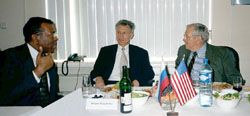
|
August 2000
Highlight |
Armenia Bulgaria Czech Republic Hungary |
Kazakhstan Lithuania Russia Slovakia |
Ukraine United States Cross-Cutting Activities Planned Activities |
Highlight
Russian nuclear safety center’s achievements featured for American visitors
On July 24, the Russian International Nuclear Safety Center (RINSC) in Moscow hosted a visit from members of the U.S. Secretary of Energy’s Advisory Board (SEAB). Center director Professor Sergei Bugaenko summarized the history of cooperation between the U.S. International Nuclear Safety Center (U.S. INSC), established in 1995, and the RINSC, formed in 1996. The RINSC originally was a part of Russia’s Research and Development Institute for Power Engineering (RDIPE); it became a separate legal entity in 1998 and now is an independent organization.
The RINSC has engaged in 10 joint research projects with the U.S. INSC. These projects are intended primarily to support DOE work to improve the safety of Soviet-designed nuclear power plants. Joint projects under the U.S. Department of Energy’s (DOE) Office of International Nuclear Safety and Cooperation include reactor safety computer codes assessment and validation, accident management techniques and technology, evaluation of U.S. and Russian coupled codes for neutronic and thermal-hydraulics safety analysis, advanced structural analysis technology, materials properties measurements, and a safety information database. RINSC specialists also provide support to two other DOE programs–Initiatives for Proliferation Prevention and the Nuclear Cities Initiative. For these programs, the RINSC has coordinated development of a nuclear safety research plan for Russia’s Ministry of Atomic Energy (MinAtom) and provides technical assistance to projects in the nuclear cities of Sarov and Snezhinsk.
 Dr. James Turner (left), director of DOE’s Office of International Nuclear Safety and Cooperation, chats with Professor Sergei Bugaenko (center), director of the Russian International Nuclear Safety Center, and Senator Howard Baker, leader of the SEAB delegation, during a luncheon meeting at the center. |
Using a combination of U.S. and Russian funding, the RINSC developed a computing center that maintains standard versions of nuclear safety computer codes, trains users from various institutes and organizations, and enables remote access to users throughout Russia and other countries of the former Soviet Union. Computer codes related to DOE’s proliferation prevention and nuclear cities initiatives also are or will be available through the RINSC computing center.
Following Professor Bugaenko’s presentation, Dr. James Turner, director of DOE’s Office of International Nuclear Safety and Cooperation, and Dr. David Hill, director of the U.S. INSC, praised the achievements of the RINSC since its inception. They especially highlighted the center’s contributions to encouraging the open and free exchange of nuclear safety information in the former Soviet Union countries, improving Russia’s nuclear safety culture, and reducing the technical isolation that characterized the Soviet Era. (Walt Pasedag, DOE, 301-903-3628; David Hill, ANL, 630-252-7112)![]()
|
August 2000
Highlight |
Armenia Bulgaria Czech Republic Hungary |
Kazakhstan Lithuania Russia Slovakia |
Ukraine United States Cross-Cutting Activities Planned Activities |